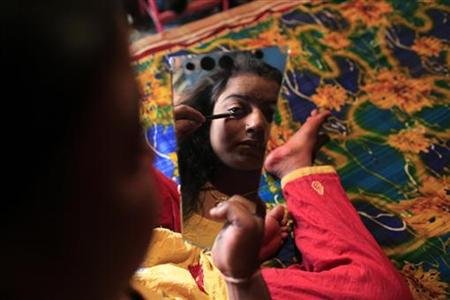
London, December 6: Younger and younger girls are being dragged into prostitution because of the global economic crisis, a conference on women's rights was told on Wednesday.
About 21 million people - or three out of 1,000 people globally - are in forced labour, meaning they have been coerced or deceived into jobs which they cannot leave, figures released by the International Labour Organisation (ILO) this year showed.
The ILO said about 4.5 million of these, mainly women and girls, were victims of sexual exploitation and overall the human trafficking trade was estimated to be worth $32 billion a year.
Ruchira Gupta, founder of Indian charity Apne Aap Women Worldwide that works with prostitutes in 10 red light districts, said cuts in funding to women's projects had reduced the options open to women and girls other than prostitution.
"We are seeing the number rise in these 10 red light districts while the age of the girls is falling," said Gupta, adding the average age of female prostitutes in India was between nine and 13.
"We need to invest more in girls and women so that there are options other than prostitution, organ trade, or (becoming) child soldiers."
While the ILO figures suggested modern-day slavery has risen to a record level, the data came with the caveat that it was hard to estimate numbers as victims were often scared to come forward and there was a lack of records in most countries.
Rising poverty was blamed for driving more women into the sex industry against their will.
David Batstone, president and co-founder of anti-trafficking organisation Not For Sale, said the global financial crisis as well as political instability created vulnerable communities at risk of exploitation.
ECONOMIC DEPRIVATION
"Where there is economic deprivation, without the rule of law to ensure the rights of people, they will be taken advantage of," Batstone told the conference organised by the Thomson Reuters Foundation and the International Herald Tribune.
Batstone said his organisation found that three out of every four prostitutes plying their trade from shop windows in the red light district of Amsterdam were now from economically desperate communities in Romania, Bulgaria and Hungary.
One such prostitute, Tsvetelina Ivanova, from Bulgaria, said once women were forced into prostitution it was hard for them to break away if they had a pimp, and move into a more normal job.
"Even when you run away you have to go back to the same job. The only good part is that at least you might work for yourself," said Ivanova, who moved to Amsterdam in 2008 and after working for two pimps now works for herself.
Lawyers told the conference that laws may exist to combat human trafficking but there were "pitifully few" prosecutions in wealthy nations like the United States where it was often overlooked or in poor countries where some families sell their children into servitude.
"Trafficking of forced labour anywhere in the world is about exploitation in the fruit and vegetable industry, on fishing boats, in brickworks," Batstone said.
Britain's shadow foreign and Commonwealth secretary, Douglas Alexander, said cuts in government spending on foreign and legal aid were also undermining the fight against trafficking and limiting legal action by victims.
"This is a constraint in every one of our countries," Alexander told the conference. "It is making the situation worse for victims of trafficking."
The ILO study, released in June, said 56 percent, or 11.7 million, of people in forced labour were in the Asia Pacific region, 18 percent in Africa, and 9 percent in Latin America.





Comments
Add new comment